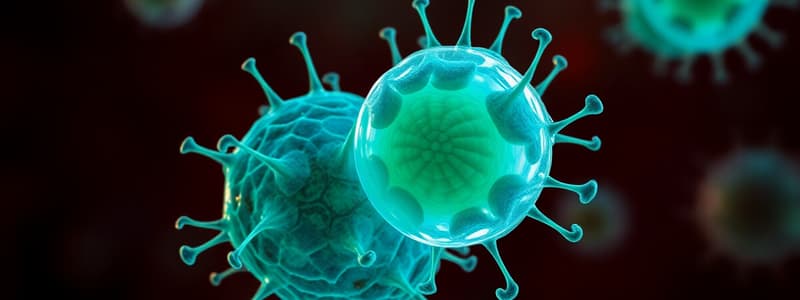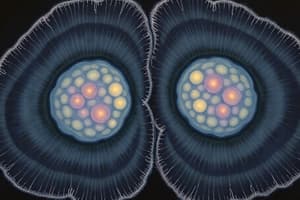Podcast
Questions and Answers
What is the primary function of cell reproduction in a multicellular organism like a human?
What is the primary function of cell reproduction in a multicellular organism like a human?
- To create genetically diverse offspring
- To produce specialized cells for different tissues
- To maintain a constant number of cells in the body
- To repair damaged tissues and promote growth (correct)
Which of the following processes is responsible for the creation of new skin cells that replace dead cells on the skin's surface?
Which of the following processes is responsible for the creation of new skin cells that replace dead cells on the skin's surface?
- Mitosis (correct)
- Asexual reproduction
- Sexual reproduction
- Meiosis
What is the difference between the epidermis and the dermis in human skin?
What is the difference between the epidermis and the dermis in human skin?
- The epidermis is the outer layer, while the dermis is the inner layer. (correct)
- The epidermis contains living cells, while the dermis contains dead cells.
- The epidermis is responsible for growth, while the dermis is responsible for repair.
- The epidermis is the inner layer, while the dermis is the outer layer.
How often do human skin cells typically reproduce?
How often do human skin cells typically reproduce?
Which of the following is NOT a characteristic of asexual reproduction?
Which of the following is NOT a characteristic of asexual reproduction?
What is the significance of the statement "All cells come from cells"?
What is the significance of the statement "All cells come from cells"?
Which of the following is an example of asexual reproduction?
Which of the following is an example of asexual reproduction?
What is the primary difference between sexual reproduction and asexual reproduction?
What is the primary difference between sexual reproduction and asexual reproduction?
What is the primary function of mitosis in multicellular organisms?
What is the primary function of mitosis in multicellular organisms?
What is the difference between chromatin and chromosomes?
What is the difference between chromatin and chromosomes?
What is the significance of the number of chromosomes in a eukaryotic cell?
What is the significance of the number of chromosomes in a eukaryotic cell?
What is the role of sister chromatids in cell division?
What is the role of sister chromatids in cell division?
Which of the following is NOT a characteristic of interphase?
Which of the following is NOT a characteristic of interphase?
What is the main difference between sexual and asexual reproduction?
What is the main difference between sexual and asexual reproduction?
How is mitosis related to the cell cycle?
How is mitosis related to the cell cycle?
Why do some cells divide more frequently than others?
Why do some cells divide more frequently than others?
What is the name of the structure that guides the chromosomes during mitosis and meiosis?
What is the name of the structure that guides the chromosomes during mitosis and meiosis?
What is the primary function of the S phase in the cell cycle?
What is the primary function of the S phase in the cell cycle?
During which phase of mitosis do the chromosomes line up at the center of the cell?
During which phase of mitosis do the chromosomes line up at the center of the cell?
What is the main difference between mitosis and cytokinesis?
What is the main difference between mitosis and cytokinesis?
What is a major event that occurs during prophase?
What is a major event that occurs during prophase?
During which phase of the cell cycle does the cell grow in size?
During which phase of the cell cycle does the cell grow in size?
What is the role of the centromere during mitosis?
What is the role of the centromere during mitosis?
What is the most likely consequence of a cell failing to complete the G1 phase correctly?
What is the most likely consequence of a cell failing to complete the G1 phase correctly?
What is the primary function of the spindle fibers during metaphase?
What is the primary function of the spindle fibers during metaphase?
What is the main difference between cytokinesis in animal cells and plant cells?
What is the main difference between cytokinesis in animal cells and plant cells?
During which stage of mitosis do the chromosomes reach the poles of the spindle?
During which stage of mitosis do the chromosomes reach the poles of the spindle?
Which of the following events occurs during the second stage of mitosis?
Which of the following events occurs during the second stage of mitosis?
What is the significance of the centromere in the process of mitosis?
What is the significance of the centromere in the process of mitosis?
Which of the following statements accurately describes the role of microtubules in mitosis?
Which of the following statements accurately describes the role of microtubules in mitosis?
Flashcards
Cell Reproduction
Cell Reproduction
The process by which cells produce new cells for growth and repair.
Epidermis
Epidermis
The outer layer of skin composed of dead and living cells.
Dermis
Dermis
The inner layer of skin that supports and nourishes the epidermis.
Mitosis
Mitosis
Signup and view all the flashcards
Asexual Reproduction
Asexual Reproduction
Signup and view all the flashcards
Sexual Reproduction
Sexual Reproduction
Signup and view all the flashcards
Cell Cycle
Cell Cycle
Signup and view all the flashcards
Human Skin Cell Reproduction
Human Skin Cell Reproduction
Signup and view all the flashcards
Chromatin
Chromatin
Signup and view all the flashcards
Chromosomes
Chromosomes
Signup and view all the flashcards
Sister Chromatids
Sister Chromatids
Signup and view all the flashcards
Interphase
Interphase
Signup and view all the flashcards
Eukaryotic Cell
Eukaryotic Cell
Signup and view all the flashcards
G1 Phase
G1 Phase
Signup and view all the flashcards
S Phase
S Phase
Signup and view all the flashcards
G2 Phase
G2 Phase
Signup and view all the flashcards
Mitotic Phase
Mitotic Phase
Signup and view all the flashcards
Spindle
Spindle
Signup and view all the flashcards
Prophase
Prophase
Signup and view all the flashcards
Metaphase
Metaphase
Signup and view all the flashcards
Mitotic spindle
Mitotic spindle
Signup and view all the flashcards
Anaphase
Anaphase
Signup and view all the flashcards
Daughter chromosomes
Daughter chromosomes
Signup and view all the flashcards
Telophase
Telophase
Signup and view all the flashcards
Cytokinesis
Cytokinesis
Signup and view all the flashcards
Animal cell cytokinesis
Animal cell cytokinesis
Signup and view all the flashcards
Plant cell cytokinesis
Plant cell cytokinesis
Signup and view all the flashcards
Study Notes
Cell Growth and Division
- All cells originate from pre-existing cells.
- The cell cycle produces new cells.
- Skin cells reproduce to replace dead cells.
- Skin consists of epidermis (outer layer) and dermis (inner layer).
- The epidermis has two layers: dead cells on top and living cells at the bottom.
- Living skin cells reproduce constantly; the new cells move outwards.
- Skin cell reproduction occurs every 24 hours.
- Renewed cell production helps wound healing.
- Mitosis is the type of cell reproduction involved in growth & repair.
- Cell reproduction also results in growth; increasing size from a baby to an adult.
- All the trillions of cells in the body originate from a single fertilized egg via cell reproduction.
Reproduction
- Cell division results in growth and repair within organisms.
- Cell division plays a significant role in creating organisms.
- Some less complex organisms reproduce via simple cell division.
- In this method, a single cell or group of cells duplicates genetic material and splits into two genetically identical cells.
- This type of reproduction is called asexual reproduction.
- Asexual reproduction involves producing offspring from one parent.
- Offspring are genetically identical to one another and their parent
- The creation of offspring from two parents is sexual reproduction.
- Sexual reproduction involves the combination of sex cells (eg: egg and sperm).
- Most multicellular organisms reproduce sexually; some also reproduce asexually.
- All multicellular organisms depend on cell division (mitosis) for growth.
Chromosomes and Cell Division
- Most eukaryotic cell genes reside in the nucleus as long, thin fibers called chromatin.
- Chromatin condenses into visible structures called chromosomes as a cell prepares to divide.
- Chromosomes are composed of DNA and protein.
- The number of chromosomes varies by species.
- Human body cells have 46 chromosomes.
Mitosis
- Before cell division can begin, a cell must first duplicate each of its chromosomes.
- Each chromosome now is called two identical sister chromatids.
- The cell cycle, in which the cell carries out metabolic processes and other functions in the body, often takes up 90% of the cycle.
- The cell cycle has three phases: G1, S and G2
- G1: cell growth; S: Duplication of genetic material; G2: cell prepares to divide.
- The mitotic phase is when the cell actively divides and involves two processes: Mitosis and cytokinesis.
- During mitosis, the nucleus and duplicated chromosomes divide equally to form two identical daughter nuclei.
- Cytokinesis begins before Mitosis completions, and involves the division of cytoplasm to form two daughter cells.
- Mitosis is divided into 4 stages: Prophase, Metaphase, Anaphase, Telophase.
The Cell Cycle
- How often a cell divides depends on its type.
- Eukaryotic cells that divide undergo a sequence called the cell cycle.
- The cell cycle is a continuous process that includes actual cell division (mitosis) and the time the cell needs to prepare for division (interphase).
Interphase
- The cell may spend as much as 90 percent of the cell cycle in interphase.
- Interphase is broken into three phases: G1, S, and G2.
- During interphase, the cell performs its metabolic processes and functions in the body.
- The cell makes duplicates of many of its organelles and grows in size during interphase.
Mitosis Phases
- Prophase: First stage of mitosis; chromatin fibers condense into chromosomes. The nucleolus disappears and the cell stops making ribosomes. The nuclear envelope breaks down, and a spindle forms.
- Metaphase: Chromosomes align in a plane across the middle of the cell. The mitotic spindle is fully formed, and spindle fibers are attached to the centromeres of each chromosome.
- Anaphase: Sister chromatids separate and move towards opposite poles of the cell. Proteins at the centromeres help move the chromosomes along the spindle fibers.
- Telophase: Chromosomes reach the poles of the spindle, and the spindle disappears. Two nuclear envelopes form around each set of chromosomes. The chromosomes uncoil and lengthen, and the nucleoli reappear.
Cytokinesis in Animals and Plants
- Cytokinesis is the actual division of the cytoplasm into two separate cells.
- In animals, an indentation (cleavage furrow) forms around the middle of the cell, and microfilaments contract, pinching the cell in two.
- In plants, a cell plate forms inside the cell, grows outward, and divides the cell into two.
Studying That Suits You
Use AI to generate personalized quizzes and flashcards to suit your learning preferences.




